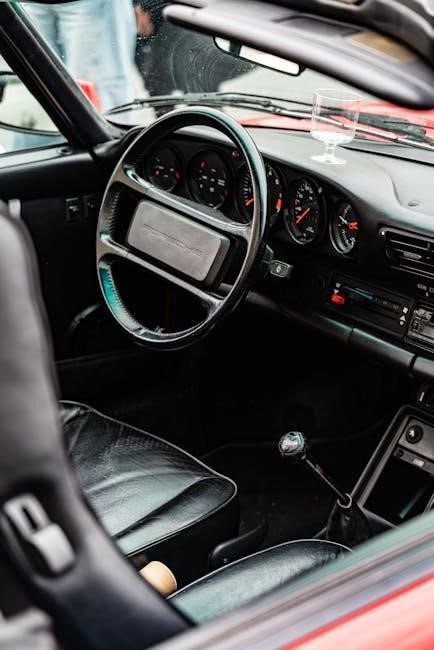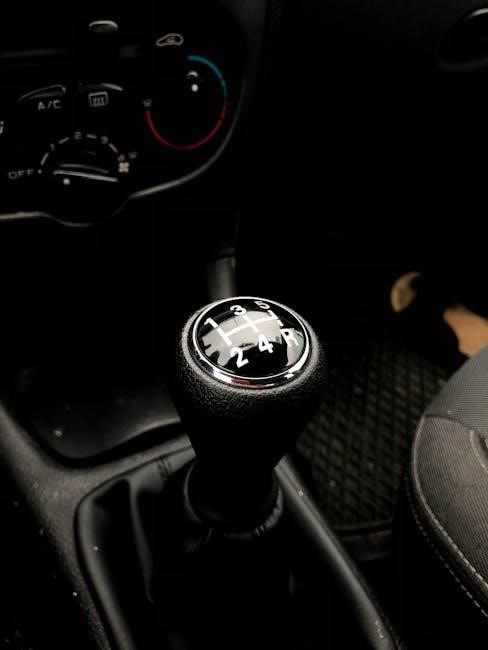Manual and CVT transmissions offer distinct driving experiences, balancing control, efficiency, and convenience. Manuals provide traditional driver engagement, while CVTs deliver seamless, adaptive performance, catering to different preferences.
Overview of Manual Transmission

A manual transmission, also known as a stick shift, is a traditional gearbox requiring driver engagement. It uses a clutch pedal and gearshift to manually change gears, offering precise control over acceleration and speed. With fewer moving parts compared to automatics, manuals are simpler, lighter, and typically more cost-effective. They are favored by driving enthusiasts for their tactile feedback and ability to optimize engine performance. However, they demand more skill and attention, as drivers must coordinate clutch presses and gear shifts. Manuals are often preferred in performance-oriented vehicles and are generally more fuel-efficient than automatics, though this can depend on driving habits and conditions.

Overview of CVT Transmission
A continuously variable transmission (CVT) is an automatic gearbox that uses belts or pulleys to provide seamless, stepless gear ratio adjustments. Unlike traditional automatics, CVTs don’t have fixed gears, allowing the engine to stay within its optimal power range. This design enhances fuel efficiency and delivers smooth acceleration without the noticeable “shifts” of conventional transmissions. CVTs are lightweight, compact, and require less maintenance than manuals or automatics. They are ideal for urban driving, offering ease of use and comfort. However, some drivers find the lack of distinct gear changes unusual, and CVTs may lack the responsiveness of manuals during aggressive driving. Overall, CVTs strike a balance between efficiency and convenience, making them a popular choice for everyday vehicles.

Fuel Efficiency Comparison
CVTs often outperform manuals and automatics in fuel efficiency due to continuous gear ratio adjustments, optimizing engine performance. Manuals can excel in specific driving conditions but vary.
How Manual Transmissions Achieve Fuel Efficiency
Manual transmissions achieve fuel efficiency by allowing drivers to control gear shifts precisely, optimizing engine speed for specific conditions. With fewer mechanical components compared to automatics, manuals reduce energy loss, enhancing efficiency. Drivers can shift to higher gears early in low-load situations, lowering RPMs and fuel consumption. Additionally, manual transmissions are generally lighter, which improves overall vehicle efficiency. The direct connection between the engine and wheels allows for better power utilization, especially in city driving or hilly terrain where control over gears is advantageous. This driver engagement and mechanical simplicity make manuals a fuel-efficient choice for skilled operators.
How CVT Transmissions Optimize Fuel Efficiency
CVT transmissions optimize fuel efficiency by continuously adjusting gear ratios to keep the engine operating at its most efficient RPM range. Unlike traditional automatic or manual transmissions, CVTs eliminate fixed gear shifts, ensuring smooth power delivery without energy loss. This adaptive nature allows the engine to maintain optimal performance under varying driving conditions, reducing fuel consumption. The absence of physical gears and lighter construction further contribute to better mileage, especially in city driving or low-load situations. By minimizing unnecessary RPM fluctuations, CVTs maximize fuel economy, making them a practical choice for drivers seeking efficiency without compromising on performance.

Driving Comfort and Convenience
CVT transmissions enhance driving comfort by eliminating manual shifting, offering smooth acceleration and reducing driver fatigue, especially in city traffic and long drives.
Ease of Driving with Manual Transmission
Manual transmissions provide a hands-on driving experience, requiring the driver to actively engage with the vehicle by using the clutch and gearshift. This can be rewarding for enthusiasts who enjoy control over acceleration and deceleration. However, it demands attention and coordination, especially in heavy traffic or hilly terrain, where frequent shifting is necessary. While it may not be as convenient as automatic or CVT options, many drivers appreciate the connection it offers to the driving process. Over time, operating a manual transmission becomes second nature, though it can be challenging for beginners to master initially.
Ease of Driving with CVT Transmission
CVT transmissions offer a highly convenient driving experience by eliminating the need for manual gear shifting. This makes them ideal for city driving and heavy traffic, where frequent acceleration and deceleration occur. The CVT’s ability to seamlessly adjust ratios ensures smooth power delivery, reducing the effort required from the driver. Unlike manual transmissions, CVTs do not require clutch operation or gear selection, making them more accessible for new drivers. The continuous flow of power also minimizes interruptions during acceleration, creating a more relaxed and less fatiguing driving experience. This simplicity and ease of use make CVT transmissions particularly suited for daily commuting and long road trips, where comfort and convenience are prioritized.

Performance and Responsiveness
Manual and CVT transmissions deliver distinct performance traits, with manuals offering precise control and CVTs providing smooth, adaptive power delivery, each catering to unique driving preferences.
Acceleration and Control with Manual Transmission
Manual transmissions provide exceptional acceleration and driver control. With precise gear shifts, drivers can optimize engine performance, especially in dynamic driving conditions. The direct connection between the driver and the vehicle enhances responsiveness, allowing for quicker acceleration and better handling on both city roads and highways. This mechanical engagement is a key reason enthusiasts prefer manual transmissions, as they offer a more immersive and interactive driving experience compared to automatic or CVT options. The ability to manually select gears ensures that power delivery is tailored to the driver’s input, making it ideal for those who value performance and driving involvement.
Smooth Power Delivery with CVT Transmission
CVT transmissions deliver smooth, uninterrupted power by eliminating traditional fixed gear shifts. This seamless operation ensures the engine operates within its optimal RPM range, providing consistent acceleration. Unlike manual or automatic transmissions, CVTs avoid abrupt gear changes, resulting in a smoother driving experience. This characteristic is particularly beneficial in stop-and-go traffic, where continuous power delivery enhances comfort and reduces driver fatigue. The absence of distinct gear shifts also minimizes jerkiness, making CVTs ideal for urban commuting and low-speed maneuvers. While some drivers may find the lack of gear changes unusual, the smooth power delivery of CVTs offers a refined and effortlessly responsive driving experience, catering to those prioritizing comfort and ease of use.

Cost and Maintenance

Manual transmissions are generally more cost-effective due to fewer moving parts, while CVTs often require specialized maintenance. Both options balance initial cost and long-term upkeep needs.
Pricing Differences Between Manual and CVT
Manual transmissions are typically more affordable upfront compared to CVT-equipped vehicles. The simpler design of manual transmissions reduces production costs, making them a budget-friendly option for car buyers. CVTs, while more complex, often come at a higher price due to their advanced technology and components. However, the long-term savings from CVT’s improved fuel efficiency can offset the initial investment for some drivers. Pricing differences also vary by brand and model, with certain manufacturers offering CVT as a standard feature in higher trim levels. Balancing initial cost and potential savings is key when deciding between these transmission types.
Maintenance Requirements for Manual vs. CVT
Manual transmissions generally require less maintenance compared to CVTs due to their simpler mechanical design. They have fewer moving parts, reducing the likelihood of components wearing out. Routine maintenance for manuals typically involves fluid changes and clutch replacements, which are relatively straightforward and cost-effective. CVTs, on the other hand, have more complex systems, including belts and pulleys, which can be more expensive to repair or replace. Additionally, CVTs often require specialized fluids and more frequent servicing to maintain optimal performance. While manuals are more durable overall, CVTs may need earlier interventions, especially if driven under harsh conditions. This makes manuals a more maintenance-friendly choice for many drivers.

Reliability and Durability
Manual transmissions are often considered more reliable and durable due to their simpler design with fewer components. CVTs, while improving, can be less consistent long-term.

Reliability of Manual Transmissions
Manual transmissions are widely regarded for their reliability and durability. With fewer moving parts compared to CVTs, they are less prone to mechanical failures. The simplicity of their design means less can go wrong, reducing the need for complex repairs. Additionally, manual transmissions often require less maintenance over time, as they lack the intricate components found in CVTs. This makes them a more cost-effective option in the long run. Their straightforward mechanism also provides drivers with a sense of control and engagement, which many prefer. While CVTs have improved in reliability, manual transmissions remain a consistent choice for those prioritizing durability and minimal upkeep.
Reliability of CVT Transmissions
CVT transmissions have historically faced reliability concerns due to their complex design. Unlike manual transmissions, CVTs rely on belts and pulleys, which can wear out over time, leading to issues like slipping or hesitation. Early models were particularly prone to these problems, though modern designs have improved significantly. However, CVTs still require precise maintenance to ensure longevity, and repairs can be costly when components fail. Despite advancements, some drivers remain skeptical about their durability compared to manuals. Nevertheless, many contemporary CVTs now offer reliable performance, especially in everyday driving conditions, making them a viable option for those seeking convenience and efficiency without the need for manual shifting.
Choosing between manual and CVT transmissions depends on personal preferences for control, efficiency, and comfort. Manuals offer driver engagement, while CVTs provide smooth, adaptive performance, each catering to different driving needs and lifestyles effectively.
Final Thoughts on Choosing Manual vs. CVT
When deciding between manual and CVT transmissions, consider your priorities. Manuals offer a more engaging driving experience with better control, while CVTs provide smooth acceleration and improved fuel efficiency. If you value the traditional feel of shifting gears and driving involvement, a manual transmission is ideal. However, for those seeking convenience and efficiency without the need for manual shifting, a CVT is a strong option. Both options have their strengths, making the choice dependent on personal preferences, driving habits, and the type of vehicle you intend to use. Balancing these factors will help you make the best decision for your needs.
